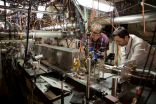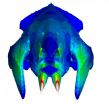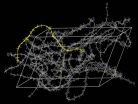Older men less likely to receive osteoporosis screening and treatment following a bone fracture
Discrepancy increases risk for future bone breaks, related complications
2014-11-05
(Press-News.org) ROSEMONT, Ill.—Osteoporosis, a common condition causing progressive bone loss and increased fracture risk, is primarily thought of as a disease affecting older women. And yet, up to one in four men over age 50 will break a bone due to osteoporosis. A study in the November 5 issue of the Journal of Bone & Joint Surgery (JBJS) found that men were three times less likely than women to undergo bone mass density (BMD) testing following a broken wrist (distal radius fracture) and seven times less likely to begin treatment for osteoporosis.
With an aging U.S. population, the likely incidence of fragility fractures ─ occurring during a fall from a standing or lower position, typically due to bone loss ─ is expected to increase two to fourfold in men and women over the next 30 years. More than 2 million men currently have osteoporosis, and more than 30 percent of hip fractures occur in men. Men have twice the mortality rate of women during the initial hospitalization and first post-fracture year following a hip fracture. Survival rates following a wrist fracture, the third most common fragility fracture and the number one upper extremity fracture in older adults, also are lower among men.
A BMD evaluation, often with Dual-Energy X-ray Absorptiometry (DXA) imaging, is standard care for women over the age of 65, and for those over age 60 who have suffered a fragility fracture or have osteoporosis risk factors. Similar recommendations have been proposed for men.
In this study, researchers retrospectively reviewed the medical records of 95 men and 344 women over the age of 50 who were treated for a wrist fracture at a single institution between 2007 and 2012. Patient injuries were assessed to determine whether or not they were screened for osteoporosis before their injury and/or if they received a DXA scan and osteoporosis treatment within six months following their wrist fracture.
Fewer men than women underwent BMD testing prior to their fracture. Following the wrist fracture, the number of men undergoing osteoporosis assessment continued to be lower: 53 percent of women (184) versus 18 percent of men (17). In addition:
Twenty-one percent of men versus 55 percent of women initiated treatment with calcium and vitamin D supplements within six months of injury, and three percent of men versus 22 percent of women started taking bisphosphonates, a common drug treatment for increasing bone mass.
Male sex, less severe fracture patterns and high-energy mechanism of injury were independent predictors of failure to initiate treatment with calcium and vitamin D.
Using the World Health Organization (WHO) online Fracture Risk Assessment Tool (FRAX), 50 percent of men who obtained a bone density test were deemed at risk for a second major osteoporotic fracture in the next decade.
Overall, the men had less severe fractures than women with 20 percent of the men and 40 percent of the women in the study having a "Type-C" fracture (a fracture involving the wrist joint).
"Treating men for bone fractures, but not the underlying cause, places them at a greater risk for future bone breaks and related complications," said lead study author Tamara Rozental, MD, associate professor of orthopaedic surgery, Harvard Medical School. "The results of this study lead us to suggest that men over the age of 50 with fractures of the distal radius should undergo bone density testing and evaluation with the FRAX algorithm to better identify those at high risk for future fracture and those who would benefit from further treatment."
INFORMATION:
Study Details
Researchers reviewed the medical records of all patients with a distal radial fracture treated at a single tertiary care institution between 2007 and 2012. Data collected included age, mechanism of injury, fracture severity, associated comorbidities, and type of treatment. Fractures were classified according to the AO Foundation and Orthopaedic Trauma Association (AO/OTA) classification system. Comorbidities were estimated with use of the Charlson comorbidity index (CCI), providing a weighted score to predict short and long-term outcomes, taking into account the number and severity of predefined comorbid conditions. The WHO online Fracture Risk Assessment Tool (FRAX) was used to estimate the 10-year risk of major osteoporotic fractures in men.
Disclosure: None of the authors received payments or services, either directly or indirectly (i.e., via his or her institution), from a third party in support of any aspect of this work. None of the authors, or their institutions, have had any financial relationship in the thirty-six months prior to the submission of this work, with any entity in the biomedical area that could be perceived to influence or have the potential to influence what is written in this work. Also, no author has had any other relationships, or has engaged in any other activities, that could be perceived to influence or have the potential to influence, what is written in this work. Also, no author has had any other relationships, or has engaged in any other activities, that could be perceived to influence or have the potential to influence what is written in this work.
ELSE PRESS RELEASES FROM THIS DATE:
2014-11-05
Research from the University of Leeds and an international team of scientists has shown a recent increase in atmospheric hydrogen chloride (HCI), a substance linked to destruction of the ozone layer.
It was anticipated that there would be a decline in HCI under the Montreal Protocol, the international treaty designed to protect the ozone layer by phasing out the production of ozone-depleting substances.
Dr Emmanuel Mahieu from the University of Liège in Belgium, who led the research, explained: "It's important to say that the Montreal Protocol is still on track, ...
2014-11-05
The first fossil of an amphibious ichthyosaur has been discovered in China by a team led by researchers at the University of California, Davis. The discovery is the first to link the dolphin-like ichthyosaur to its terrestrial ancestors, filling a gap in the fossil record. The fossil is described in a paper published in advance online Nov. 5 in the journal Nature.
The fossil represents a missing stage in the evolution of ichthyosaurs, marine reptiles from the Age of Dinosaurs about 250 million years ago. Until now, there were no fossils marking their transition from land ...
2014-11-05
Many fire scientists have tried to get Smokey the Bear to hang up his "prevention" motto in favor of tools like thinning and prescribed burns, which can manage the severity of wildfires while allowing them to play their natural role in certain ecosystems.
But a new international research review led by the University of California, Berkeley, says the debate over fuel-reduction techniques is only a small part of a much larger fire problem that will make society increasingly vulnerable to catastrophic losses unless it changes its fundamental approach from fighting fire ...
2014-11-05
BOSTON – Each year nearly two million Americans suffer osteoporosis-related fractures, and as the population ages that number is expected to increase dramatically, placing a major burden on the health care system. While osteoporosis prevention and treatment efforts have historically been focused on post-menopausal women, a new study from Beth Israel Deaconess Medical Center (BIDMC) suggests that critical opportunities are being lost by not focusing more attention on bone loss and fracture risk in older men.
"Given that the prevalence of fragility fractures among ...
2014-11-05
When it comes to genitalia, nature enjoys variety. Snakes and lizards have two. Birds and people have one. And while the former group's paired structures are located somewhat at the level of the limbs, ours, and the birds', appear a bit further down. In fact, snake and lizard genitalia are derived from tissue that gives rise to hind legs, while mammalian genitalia are derived from the tail bud. But despite such noteworthy contrasts, these structures are functionally analogous and express similar genes.
How do these equivalent structures arise from different starting ...
2014-11-05
Scientists from the Department of Energy's SLAC National Accelerator Laboratory and the University of California, Los Angeles have shown that a promising technique for accelerating electrons on waves of plasma is efficient enough to power a new generation of shorter, more economical accelerators. This could greatly expand their use in areas such as medicine, national security, industry and high-energy physics research.
This achievement is a milestone in demonstrating the practicality of plasma wakefield acceleration, a technique in which electrons gain energy by essentially ...
2014-11-05
AMHERST, Mass. – The surprise discovery of the fossilized skull of a 66- to 70-million-year-old, groundhog-like creature on Madagascar has led to new analyses of the lifestyle of the largest known mammal of its time by a team of specialists including biologist Elizabeth Dumont at the University of Massachusetts Amherst, an expert in jaw structure and bite mechanics.
The skull of this animal, named Vintana sertichi, was found in a geological formation deposited when a great variety of dinosaurs roamed the earth. With a skull that is almost five inches (125 mm) ...
2014-11-05
A new study led by the University of California, Berkeley and involving the University of Colorado Boulder indicates the current response to wildfires around the world—aggressively fighting them—is not making society less vulnerable to such events.
The study suggests the key is to treat fires like other natural hazards—including earthquakes, severe storms and flooding—by learning to coexist, adapt and identify vulnerabilities. The new study indicates government-sponsored firefighting and land management policies may actually encourage development ...
2014-11-05
Australian researchers have shown why calcium-binding drugs commonly used to treat people with osteoporosis, or with late-stage cancers that have spread to bone, may also benefit patients with tumours outside the skeleton, including breast cancer.
Several clinical trials – where women with breast cancer were given these drugs (bisphosphonates) alongside normal treatment for early-stage disease – showed that they can confer a 'survival advantage' and inhibit cancer spread in some women, although until now no-one has understood why.
A new study by Professor ...
2014-11-05
Researchers from the University of Cambridge have identified a class of low-cost, easily-processed semiconducting polymers which, despite their seemingly disorganised internal structure, can transport electrons as efficiently as expensive crystalline inorganic semiconductors.
In this new polymer, about 70% of the electrons are free to travel, whereas in conventional polymers that number can be less than 50%. The materials approach intrinsic disorder-free limits, which would enable faster, more efficient flexible electronics and displays. The results are published today ...
LAST 30 PRESS RELEASES:
[Press-News.org] Older men less likely to receive osteoporosis screening and treatment following a bone fracture
Discrepancy increases risk for future bone breaks, related complications





